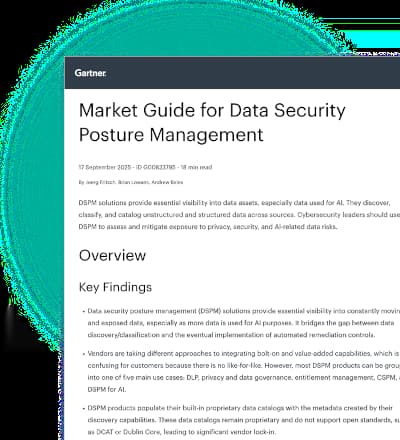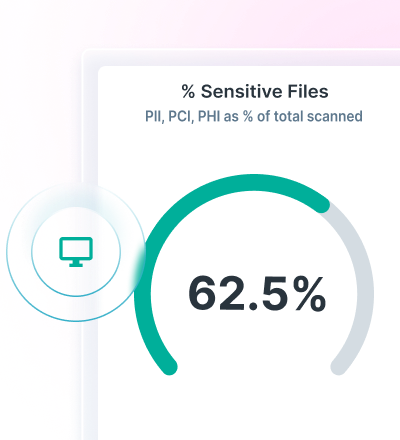
Mais de 12 mil clientes não poderiam estar errados










































Proteja a navegação na internet
e evite violações de dados
A Internet é essencial para a mão-de-obra moderna, mas implica em riscos. O Forcepoint Web Security assegura e promove a inovação digital e a produtividade, protegendo o tráfego e os dados na Web contra ransomware e ameaças de dia zero.
Por que escolher a Forcepoint Web Security
Controle dados confidenciais na internet
Identifique e bloqueie tentativas de exfiltração ou vazamentos de dados potencialmente perigosos em qualquer lugar da web.
Bloquear ameaças baseadas em web
O Advanced Classification Engine (ACE) da Forcepoint evita ataques de dia zero e ataques conhecidos de ransomware.
Descubra e monitore Shadow IT
Localize atividades não autorizadas da Web e de SaaS e proteja aplicativos emergentes, como ChatGPT e IA generativa.
Entregue desempenho consistente
Forneça aos usuários acesso seguro e confiável à internet, onde quer que estejam.
Forcepoint versus concorrência
Forcepoint | Fornecedores de segurança legados | Fornecedores de redes legados | |
Recursos do Secure Web Gateway (SWG)
| |||
Recursos de Data Security
|
AVISO LEGAL a comparação de produtos é baseada nos recursos do produto e nas integrações entre portfólios disponíveis do mesmo fornecedor a partir de 1º de março de 2023. As comparações não incluem integrações com fornecedores terceirizados. A comparação de recursos é baseada na versão mais recente e moderna de cada fornecedor, disponível em 1º de março de 2023. As informações baseiam-se em dados coletados de sites de Internet e fóruns públicos, textos de analistas e descritivos de produtos em 1º de março de 2023.


Proteja os dados na web
Descubra como estender a Segurança de Dados para a Web com sua solução de gateway de web segura. Veja como o Forcepoint Web Security permite que as organizações protejam os dados dentro de qualquer aplicativo web.
Acesse sites arriscados com segurança
Forneça proteção adicional contra ameaças por meio de uma integração do Forcepoint Remote Browser Isolation (RBI) com o Forcepoint Web Security. O RBI renderiza sites potencialmente arriscados em um contêiner para evitar a iniciação de ataques de malware.
Defender contra ameaças avançadas
Expanda os recursos de detecção de ameaças por meio da integração do Forcepoint Advanced Malware Detection and Protection (AMDP) com o Forcepoint Web Security. O AMDP detecta rapidamente ameaças de malware conhecidas e desconhecidas e ataques de dia zero para manter os dados seguros.
Por que os clientes escolhem o Forcepoint Web Security
Por que os clientes escolhem o Forcepoint Web Security

"It's easy to install and configure. Simple to manage SWG, CASB and ZTNA from a single console. The RBI and CDR features of SWG is impressive and useful to protect and browse fearlessly."
Read Full ReviewFique informado para proteger seus dados
Perguntas frequentes
O que é um Secure Web Gateway (SWG)?
Um SWG é uma tecnologia de segurança projetada para proteger organizações, redes, usuários e dispositivos contra ameaças relacionadas à Internet. Os SWGs realizam duas funções principais: eles filtram o conteúdo inseguro do tráfego da web e bloqueiam o comportamento do usuário arriscado ou não autorizado.
Como funciona um SWG?
Um SWG pode ser uma solução de software, um serviço baseado na nuvem ou um dispositivo físico. Posicionados na borda de uma rede, os SWGs inspecionam o tráfego de entrada e saída, usando a política da empresa para determinar se o tráfego da web deve ser permitido, bloqueado ou colocado em quarentena. Os recursos de um SWG podem incluir:
- Filtragem de URLs
- Controle de aplicativos
- Software antivírus
- Inspeção de HTTPS
- Detecção e bloqueio de antimalware
- Controle de acesso
Quais são os benefícios de um SWG?
Com a tecnologia SWG, as organizações podem:
- Controle os dados confidenciais na web
- Impeça as ameaças baseadas na web
- Descubra e monitore a shadow IT
- Entregue um desempenho consistente
O que é uma solução de segurança da web?
Uma solução de segurança da web foi projetada para proteger sites, aplicativos da web e outros recursos da web contra uma ampla variedade de ameaças cibernéticas. Embora uma variedade de soluções tenha sido desenvolvida para melhorar a segurança da web, essas tecnologias são com mais frequência combinadas em um SWG.
Por que as soluções de segurança da web são importantes?
As soluções de segurança da Web, como um SWG, tornaram-se uma parte indispensável da pilha de segurança à medida que as ameaças se tornam mais sofisticadas e os ambientes de TI mais complexos. O perímetro de rede tradicional praticamente desapareceu, graças a grandes transformações de TI, como computação em nuvem, BYOD, forças de trabalho híbridas e dependência de aplicativos SaaS. As soluções de segurança da Web legadas que exigem que todo o tráfego seja roteado por um hub central para inspeção de segurança podem adicionar latência severa às conexões de rede, dificultando a produtividade e limitando a competitividade.
O que é um gateway de segurança da web?
Um gateway de segurança da Web impede que ameaças baseadas na Web entrem na rede de uma organização e bloqueia os usuários de acessar recursos da Web que podem conter malware, vírus e outras ameaças. Um gateway seguro da web serve como um ponto de verificação, ficando entre a rede interna de uma organização e a Internet para inspecionar o tráfego que flui de e para a web. Os gateways de segurança da Web empregam uma variedade de tecnologias, como filtragem de URLs, detecção de malware, controle de aplicativos e inspeção de tráfego criptografado, oferecendo maior visibilidade do tráfego e uso da web.
O que é um dispositivo de segurança da web?
Um dispositivo de segurança da Web ajuda a proteger organizações e usuários contra ameaças relacionadas à Internet, como malware, vírus, sites falsificados, ataques de phishing e muito mais. Os dispositivos de segurança da Web também podem ajudar a evitar vazamentos de dados, controlar o uso de aplicativos, melhorar a visibilidade da atividade da Web e aplicar a política de segurança em toda a organização.
O que é um gateway seguro da web?
Um gateway seguro da web é um produto de cibersegurança que ajuda a proteger as organizações contra ameaças relacionadas à web, aplicando políticas de segurança para tráfego da web de entrada e saída.
O que é um serviço de SWG?
Um serviço SWG é uma solução baseada na nuvem que monitora todo o tráfego que entra em um ambiente de TI a partir da web, bem como todas as solicitações de saída da web de usuários de uma organização.














